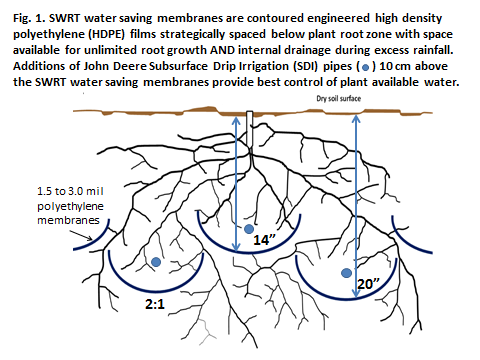Field report: New water retention membranes demonstrate promising results in two growing seasons
MSU AgBioResearch soil scientist Alvin Smucker describes his innovative SWRT (subsurface water retention technology) technology and how it's being used to enhance the growth of corn and soybean plants.

EAST LANSING, Mich. – MSU AgBioResearch soil scientist Alvin Smucker was standing in a sandy research plot on the Sand Hill Farm south of campus where cornstalks differ dramatically in height every few yards. He quickly explained that the shorter, yellower plants are nutrient-deficient because of excessive leaching of nitrogen in the absence of SWRT membranes.
SWRT stands for “subsurface water retention technology,” a patented process that Smucker and his co-workers developed to retain water and nutrients in highly permeable soils. The SWRT process utilizes a thin sheet of polyethylene, a common plastic, buried by a newly patented machine. The machine deposits the plastic sheets in a U-shaped pattern at alternating depths of 14 and 20 inches. Rows of the impermeable polyethylene are spaced 12 inches apart to encourage root growth and drainage of excess water around these layers (see diagram).
It is a concept that Smucker, an MSU professor of soil biophysics, borrowed from observations of natural clay layers in some sandy soils that typically have better aboveground productivity than adjacent sandy areas without natural water barriers.
“Typically, rain carrying nutrients leaches through the soil until something stops it – a fine layer of clay or, in this case, the highly inert polyethylene film,” he said.
Although soil scientists and engineers developed water retention membranes for use on sandy soils more than 45 years ago, Smucker said his method is comparatively less costly ($800 to $1,500/acre) and also provides adequate soil aeration and proper drainage. The system is also expected to last 40 years and possibly much longer -- up to hundreds of years, Smucker said. He is projecting full returns on the installation costs within the first three to five years through savings on irrigation water and fertilizer coupled with extraordinary yield increases.
Using SWRT, Smucker has been able to transform sandy soils near campus and research plots in Benton Harbor into lush corn, soybean and cucumber fields over the past three years despite drastically different growing conditions (last year was the drought; this year has been wet and cool). It is a revelation he believes has implications in Michigan, where there are more than 2 million acres of sandy soil, as well as in agricultural regions across the United States and around the world.
“There are approximately 24 billion acres of sandy soils in the world, so this new SWRT production system could have huge agricultural production contributions globally,” he said. “These new SWRT applications in sandy soils offer the potential to transform barren landscapes into sustainable plant production regions that improve lives and transform communities.”
SWRT research and modeling has attracted numerous visitors and exchange graduate students. Zouheir Massri, a dryland research scientist from Syria, recently has been working with Smucker to assess the nutrient balances among SWRT research test plots.
“We know the specific quantity of water that is most efficiently absorbed by the plant,” Smucker said. “So, instead of planting a crop and hoping that it rains, we can use SWRT water-retaining membranes to prescriptively apply predetermined volumes of water at regular intervals because we know how much water and nutrients can be retained in the root zones of plants.”
Both yield and biomass data already collected appear promising. SWRT field research has shown the system can supply up to 100 percent of plant water demands for periods up to four times longer than soils without water retention membranes. Production yields have also increased between 50 and 200 percent in various vegetable, grain and biomass cropping systems. In Michigan, green bell pepper and cucumber yields doubled with 60 percent less water.
This is the second year of testing the SWRT prototype on the MSU campus and the third year of field tests at the MSU Southwest Michigan Research and Extension Center near Benton Harbor. Smucker has secured grant funds from the USDA-NRCS (National Resources Conservation Services) for multistate on-farm demonstrations that will test the SWRT accelerations of cellulosic biomass, vegetable and row crop production systems in Arizona and states along the Mississippi River basin.



 Print
Print Email
Email





